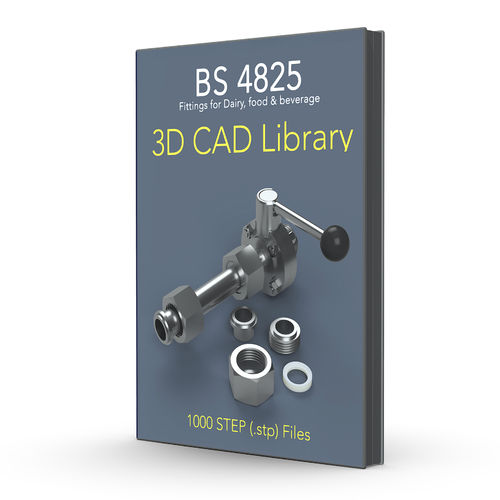Premium Quality 3D CAD Files for Your Engineering Projects
3D CAD Files Collections Info for 3D CAD Engineers Hygienic Stainless Steel
Designing hygienic process systems: About stainless steel

Stainless Steel in Process Equipment for Hygienic Industries: An Extensive Exploration
In modern hygienic industries, where dairy products, beer, food, and pharmaceuticals are manufactured, process piping plays a crucial role. These pipelines serve as the veins of production facilities, responsible for transporting raw materials, intermediates, and finished products. One of the most commonly used materials for these pipelines is stainless steel (SS), due to its excellent properties such as corrosion resistance, hygiene, and durability. This comprehensive article delves deeply into the use of stainless steel in process piping for hygienic applications, with a focus on the differences between two commonly used types: AISI304 and AISI316.
1. Introduction to Stainless Steel in Hygienic Industries
Hygienic industries encompass sectors where products are manufactured for human consumption or application, with stringent standards for hygiene and safety. These include:
- Dairy Industry: Production of milk, cheese, yogurt, etc.
- Breweries: Manufacture of beer and other beverages.
- Food Processing: Processing of meat, fish, vegetables, etc.
- Pharmaceutical Industry: Production of medicines and medicinal products.
In all these industries, it's essential to use materials that meet the highest standards of hygiene, durability, and safety. Stainless steel is one of the most suitable materials due to its unique properties.
2. Advantages of Stainless Steel in Process Piping
Stainless steel offers several advantages that make it ideal for use in process piping within hygienic industries:
Corrosion Resistance: One of the key advantages of stainless steel is its excellent resistance to corrosion. This is due to the passive oxide layer formed on the material's surface, making it resistant to oxidation and corrosion in aggressive environments.
Hygienic Properties: The smooth surface of stainless steel makes it easy to clean and sterilize. This is crucial in hygienic industries, where strict cleaning procedures are employed to ensure product safety and quality.
Durability: Stainless steel withstands extreme temperatures, pressure, and mechanical loads, making it a durable and reliable option for process piping requiring long-term performance.
Aesthetics: In addition to its functional benefits, stainless steel also has aesthetic appeal, making it often chosen for applications where appearance matters, such as in public spaces or design-oriented installations.

3. Types of Stainless Steel in Hygienic Industries
While there are various types of stainless steel, AISI304 and AISI316 are the most common types used in hygienic industries. These two types differ in chemical composition and properties, influencing their suitability for specific applications.
AISI304:
AISI304, also known as 1.4301 or V2A, is an austenitic stainless steel characterized by its high chromium content (approximately 18%) and nickel content (approximately 8%). Some key properties of AISI304 include:
- Good overall corrosion resistance: AISI304 provides good protection against many common corrosive substances and mild acids. However, it is less resistant to chlorides than AISI316.
- Excellent formability and weldability: AISI304 is easy to fabricate and weld, making it suitable for various manufacturing processes.
- Suitability for moderate environments: Due to its good overall corrosion resistance, AISI304 is often used in applications where the environment is not particularly aggressive.
AISI316:
AISI316, also known as 1.4401 or V4A, is also an austenitic stainless steel, but with a slightly different chemical composition than AISI304. It contains about 16% chromium, 10% nickel, and an addition of molybdenum (approximately 2-3%). Some key properties of AISI316 include:
- Excellent corrosion resistance: AISI316 offers superior corrosion resistance, especially in chloride-rich environments such as seawater or industrial processes where salts are present.
- Higher cost: Due to the addition of molybdenum and the higher nickel content, AISI316 is generally more expensive than AISI304. This can be a factor in choosing the material for certain applications.
- Applications in demanding environments: Because of its superior corrosion resistance, AISI316 is often used in marine applications, chemical processing, and pharmaceutical production where the environment is particularly aggressive.
4. Applications of Stainless Steel in Hygienic Industries
The use of stainless steel in hygienic industries is broad and varied, ranging from process piping to tanks, pumps, valves, and other components. Below are some of the key applications of stainless steel in these industries:
Process Piping: This is one of the most prominent applications of stainless steel in hygienic installations. Process piping transports liquids and other materials throughout the production facility, and the use of stainless steel ensures product integrity and compliance with hygienic standards. The choice between AISI304 and AISI316 depends on factors such as the corrosive environment, desired lifespan, and budget.
Tanks and Vessels: Tanks and vessels are used for storing raw materials, intermediates, and finished products. Stainless steel tanks provide a hygienic and durable storage solution, and are easy to clean and sterilize. AISI316 is often used for tanks in industrial environments where corrosive substances are present.
Pumps and Valves: Pumps and valves play an essential role in regulating and moving fluids within production facilities. Stainless steel pumps and valves offer corrosion resistance and hygienic properties, crucial for maintaining product quality.
Heat Exchangers: Heat exchangers are used for heating or cooling fluids and are widely used in processes such as pasteurization and sterilization. Stainless steel heat exchangers provide an efficient and hygienic solution, making them ideal for applications in the food and beverage industry.
Piping Accessories: In addition to the main components such as pipes, tanks, and pumps, various accessories are required for a well-functioning process. These include fittings, pipe clamps, flanges, and seals, all of which are available in stainless steel versions for maximum hygiene and durability.

5. Factors in Choosing between AISI304 and AISI316
When selecting the right type of stainless steel for a particular application, several factors need to be considered:
Environmental Conditions: The nature of the environment in which the equipment is used, such as the presence of chlorides, acids, or other corrosive substances, is a crucial consideration. AISI316 is recommended for applications in aggressive environments, while AISI304 is suitable for moderate conditions.
Budget: The cost of the material also plays a role in material selection. AISI316 is generally more expensive than AISI304 due to the addition of molybdenum and the higher nickel content. It's important to weigh the budget against performance requirements and the expected lifespan of the equipment.
Desired Lifespan: For installations requiring a long lifespan and minimal maintenance requirements, AISI316 may be preferred due to its superior corrosion resistance and durability. For installations where the environment is less aggressive and regular maintenance is possible, AISI304 may be a cost-effective choice.
Regulations and Standards: In some cases, regulations and standards may impose specific requirements on the use of certain materials in particular applications. It's important to consult these regulations when selecting the material for a specific application.
Related articles
-
Standards for Hygienic Fittings in Dairy & Food Production
-
Designing hygienic process systems: The DIN-EN standards
-
Designing hygienic process systems : The BS4825 standards
-
Designing hygienic process systems: The main coupling types compared
-
Designing hygienic process systems: Tri-clamp ferrule dimensions
Check out our 3D CAD Libraries
BS4825 Hygienic Fittings and Valves - 1000 STEP FilesDownload this complete 3D CAD library (2 zip files) and get access to 1000 premium quality hygienic BS4825 fittings! (in STEP file format). |
ASME-BPE Hygienic Fittings and Valves - 500 STEP FilesDownload this complete 3D CAD library (1 zip file) and get access to 500 premium quality hygienic ASME-BPE fittings! (in STEP file format). |
DIN-EN Hygienic Fittings and Valves - 700 STEP FilesDownload this complete 3D CAD library (1 zip file) and get access to 700 premium quality hygienic DIN-EN fittings! (in STEP file format). |


